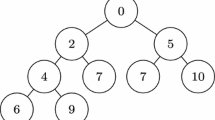Abstract
Branching rules are an integral component of the branch-and-bound algorithm typically used to solve mixed-integer programs and subject to intense research. Different approaches for branching are typically compared based on the solving time as well as the size of the branch-and-bound tree needed to prove optimality. The latter, however, has some flaws when it comes to sophisticated branching rules that do not only try to take a good branching decision, but have additional side-effects. We propose a new measure for the quality of a branching rule that distinguishes tree size reductions obtained by better branching decisions from those obtained by such side-effects. It is evaluated for common branching rules providing new insights in the importance of strong branching.
Access this chapter
Tax calculation will be finalised at checkout
Purchases are for personal use only
Similar content being viewed by others
References
Achterberg, T. (2007). Constraint Integer Programming. Ph.D. thesis. Technische Universität, Berlin.
Achterberg, T., & Berthold, T. (2009). Hybrid Branching. In W. J. van Hoeve & J. N. Hooker (Eds.), CPAIOR 2009 (Vol. 5547, pp. 309–311). LNCS, Springer.
Achterberg, T., Koch, T., & Martin, A. (2005). Branching rules revisited. Operations Research Letters, 33, 42–54.
Benichou, M., et al. (1971). Experiments in mixed-integer linear programming. Mathematical Programming, 1, 76–94.
COR@L MIP Instances. Accessed June 2017. http://coral.ise.lehigh.edu/data-sets/mixedinteger-instances/.
Gamrath, G. (2014). Improving strong branching by domain propagation. EURO Journal on Computational Optimization, 2(3), 99–122.
Gauthier, J. -M., & Ribière, G. (1977). Experiments in mixed-integer linear programmingusing pseudo-costs. Math Prog, 12(1), 26–47.
Koch, T., et al. (2011). MIPLIB 2010. Mathematical Programming Computation, 3(2), 103–163.
Land, A. H., & Doig, A. G. (1960). An automatic method of solving discrete programming problems. Econometrica, 28(3), 497–520.
Acknowledgements
The work for this article has been conducted within the Research Campus Modal funded by the German Federal Ministry of Education and Research (fund number 05M14ZAM).
Author information
Authors and Affiliations
Corresponding author
Editor information
Editors and Affiliations
Rights and permissions
Copyright information
© 2018 Springer International Publishing AG, part of Springer Nature
About this paper
Cite this paper
Gamrath, G., Schubert, C. (2018). Measuring the Impact of Branching Rules for Mixed-Integer Programming. In: Kliewer, N., Ehmke, J., Borndörfer, R. (eds) Operations Research Proceedings 2017. Operations Research Proceedings. Springer, Cham. https://doi.org/10.1007/978-3-319-89920-6_23
Download citation
DOI: https://doi.org/10.1007/978-3-319-89920-6_23
Published:
Publisher Name: Springer, Cham
Print ISBN: 978-3-319-89919-0
Online ISBN: 978-3-319-89920-6
eBook Packages: Business and ManagementBusiness and Management (R0)




